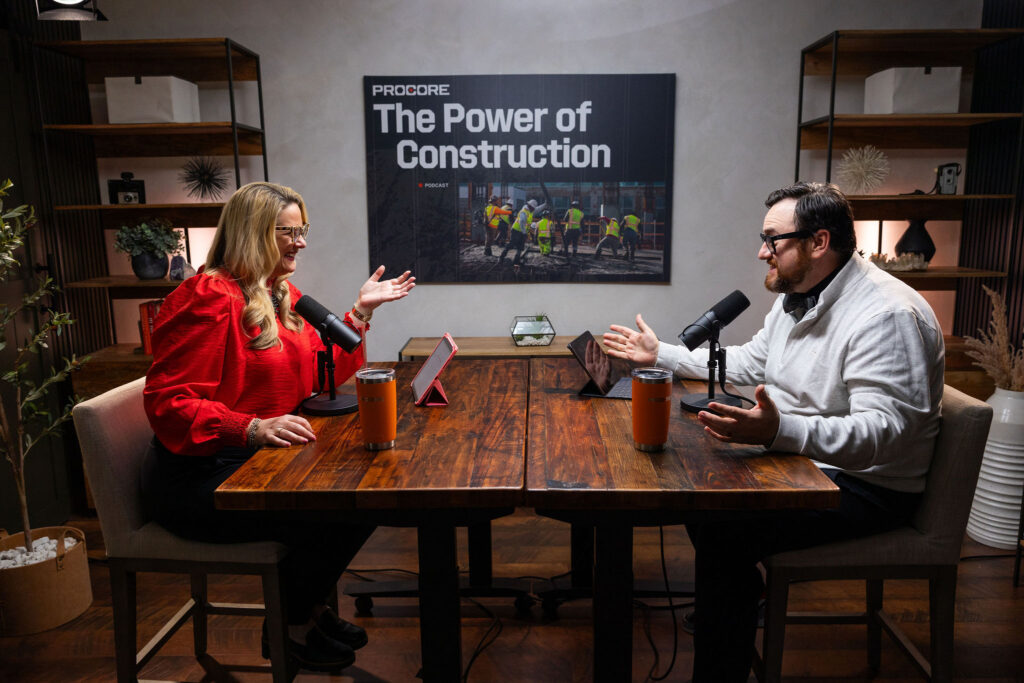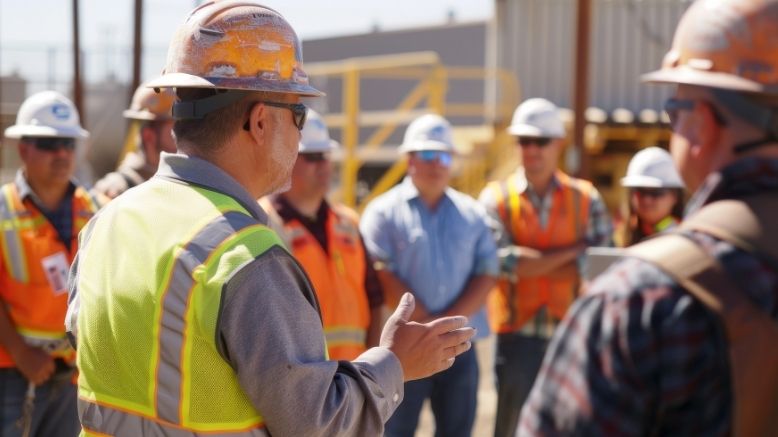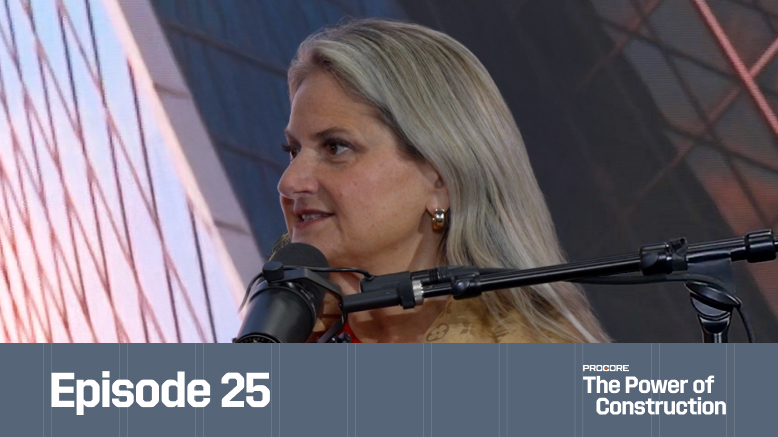The Mental Health Crisis in Construction
Behind every safety incident is a person—and behind that person is a story we rarely ask about. Construction has experienced high growth in suicide rates, with 99% being men. In the UK, construction workers are four times more likely to die from suicide than the national average. This isn't just a UK issue—it's a global challenge affecting countries that track this data.
In 2023, Procore joined forces with Fred Mills from the B1M to create Get Construction Talking, a campaign that has reached over 20 million people and raised nearly half a million pounds for organizations addressing mental health in construction.
Recent research from Procore shows that 51% of construction leaders want better work-life balance, 40% want stronger focus on worker well-being, and 47% believe technology can boost both safety and efficiency.
What the Data Reveals About Worker Struggles
Research conducted in 2022 found that a third of construction workers were living with severe levels of anxiety. Recent CIOB data shows 9% think of suicide often—a concerning increase from previous data collection.
While awareness-raising activities saw a three-fold increase from 22% to 76%, workers still experience significant stigma in talking about mental health concerns (around 70%). However, a similar number had recently helped someone else with their mental health, suggesting people feel more comfortable supporting others than seeking help themselves.
Most concerning are the workplace impacts: 52% report fatigue, 46% report irritability, and 48% report poor concentration—all interconnected symptoms that affect both safety and productivity at work and quality of life at home.
Financial Vulnerability and Long Hours
Focus groups with on-the-tools workers revealed three critical challenges.
First, financial vulnerability creates constant stress—not knowing when you'll get paid or if you'll receive the contracted amount means workers live on a knife edge, unable to plan for housing and food costs. This is particularly acute given that many entering construction already come from backgrounds with financial instability.
Second, long working hours become unavoidable when workers feel financially vulnerable—they can't say no to extra hours, jobs away from home, or sixth-day work. While some workers thrive on contracted periods of intense work followed by time off, those who struggle find their relationships, healthy living practices, exercise routines, and access to daylight all suffer.
Third, workers often use unhealthy coping mechanisms like online gambling, pornography, or substances to decompress from stress.
The Human Cost of Disconnection
Construction provides work families, long-term careers, good income, and development opportunities for many. However, the working environment often prevents genuine connection between people. Loud environments, PPE requirements, isolated work in vans, moving between sites, and frequent project changes all contribute to workers feeling disconnected.
One worker shared that they only got spoken to when being corrected about not wearing safety glasses—never for recognition or genuine conversation. This lack of being known, valued, and cared about as individuals prevents the inclusive environment where people can thrive, do their best work, and communicate ideas for improvement.
Without these connections, workers feel compelled to mask their differences and struggles rather than seeking support.
Personal Connection: Growing Up in Construction
Jenny McLaughlin has been impacted by construction since birth. Her father was a structural engineer, and she first visited construction sites at six or seven years old. She has fond memories of the care workers showed her on those sites, instilling a deep respect for the humans who build. Her mother was the first female director at CITB for training. Her husband is a senior construction manager who worked at ISG, giving Jenny firsthand knowledge of what happens when companies struggle and how that impacts families.
She emphasizes that construction documentation and processes often remove the human element—even digital models show components assembling like Disney's Fantasia but never include a single human being. This dehumanization makes the industry forget there are humans who build, and that decisions aren't made in a vacuum but within an ecosystem where choices massively impact how workers show up and go home.
System Failure, Not Human Error
The cost of error in construction is enormous, and many companies face financial insecurity partly because of accumulated errors. However, labeling incidents as "human error, full stop" is fundamentally wrong. Research consistently shows that human error is rarely the actual issue—the systematic failures are.
With one in four construction workers being neurodivergent and many workers speaking English as a second language, communication must be more accessible and inclusive. Otherwise, the system creates conditions where errors occur. Workers become the last line of defense, but if we don't design around human ergonomics and human factors, we're setting them up to fail.
Aviation achieves high safety levels because human factors play a massive role in how the industry designs systems, ensuring individuals have the best possible ability to make right decisions at the right time with built-in fail-safes. Construction rarely reflects on root causes or asks critical questions: Was the information understandable? Were work hours preventing sleep? When did they last eat and what was that meal? All these factors determine whether someone is operating at their best.
The Power of Pause
The power of pause is severely underestimated in construction mental health and project delivery. Workers often don't trust the system enough to voice concerns that a pause might be needed. On projects where Jenny McLaughlin has enforced pauses, teams have successfully regained control and moved forward in more positive ways.
Root cause analyses in construction rarely consider human factors—it's quick to identify process failures or platform failures, but the question of what someone was going through that could have impacted their performance is almost never asked. This represents a fundamental gap in how the industry approaches safety incidents and errors, missing the opportunity to address underlying systematic issues that create conditions for mistakes.
Creating Caring Cultures Through Clear Actions
Mates in Mind's approach focuses on creating work environments where workers have positive experiences and work has a beneficial impact on mental health. Organizations report wanting clear actions to create positive change, coming from a caring-based position with good intent for employees and supply chain partners. There's recognition that efficiency, effectiveness, minimal errors, and productivity all flow from supporting worker well-being. The crux is worker engagement—wanting workers engaged both at work and at home.
To achieve this, organizations must change their culture through three intervention points. First, develop emotional literacy so workers can feel a feeling, name it, describe it to others, and understand this is positive. Second, ensure managers invite these conversations, asking "How are you? What's going on? How did you sleep?" (The more uncomfortable people are with sleep questions, the more it needs asking.) Third, prepare leaders to lead well because they set culture, including through reverse mentoring where experts by experience offer critical friendship to leaders, helping them consider the mental health impacts of their decisions.
Activating Mental Health First Aiders as Change Agents
While awareness-raising has seen the biggest growth, research indicates it hasn't been an effective intervention on its own. There's a huge cohort of trained mental health first aiders who are passionate, volunteered, and waiting to help, but they need activation.
Mates in Mind brings them together into networks where they have peer connection, resources, and can become change agents working through the sector in connected ways. This work is being embedded at multiple entry points: construction schools, apprenticeship programs, and organizations taking apprentices.
The goal is creating emotional literacy and invitation to conversation at all points throughout the sector, combined with recommendations for changing working practices based on research findings and examples of organizations doing it well.
Team Heathrow: Designing Safety Into the Supply Chain
Heathrow's vision is Team Heathrow—regardless of where you are in the supply chain or which badge you wear, you're working for one team. This ethos manifests in several practical ways.
First, they enforce minimum PPE standards throughout the supply chain. PPE is the last line of defense in safety, yet many organizations don't ensure consistent quality and standards across tiers. Workers were arriving with market-bought items that looked like PPE but met no safety standards. By providing minimum standard PPE to everyone, Heathrow demonstrates that every person has value and deserves proper safety equipment. They also recognized that face masks are designed for male Caucasian faces, meaning they don't properly protect the actual demographic diversity on sites.
Second, they ensure equivalent welfare facilities and EAP (Employee Assistance Program) resources across the supply chain, with workers able to access any tier one contractor's EAP to reduce stigma around seeking help from their direct employer.
Shift Patterns and Work-Life Balance
When Heathrow needed to change shift patterns on a project, Jenny McLaughlin made a discovery that changed her approach forever. She had assumed shift changes would be inconsequential—workers would simply arrive and leave at different times. However, consulting the actual workforce revealed that many night shift workers had structured their entire family lives around their schedules.
They would get home from night shift, drop children at school so their partner could go to work, be present when kids came home for quality time, sleep in between, then return to work. The proposed two-hour shift change would have destroyed these carefully balanced family systems.
Rather than prioritizing project efficiency and timelines over worker well-being, they didn't make the change. Beyond moral considerations, there's a skill gap in the industry—they couldn't afford to lose these workers or have them working in poor mental states, especially in night environments.
Heathrow is exploring three-shift systems instead of two, which could provide better work-life balance for individuals while accounting for the reality that two-hour commutes each way create workdays far longer than the actual shift hours—particularly impactful for physically demanding construction work.
The Reality of Travel and Cognitive Load
Project assignments often don't consider worker location, leading to situations where someone living in East London works a West London project while someone else does the reverse—preventable inefficiencies that significantly impact well-being.
More drastically, Jenny's husband faced project options in Dover, Cambridge, and Chipping Norton—impossibly spread locations that made any choice difficult. The long commutes meant he came home incapable of doing anything else, creating resentment in their relationship even when both understood the situation intellectually. This dynamic of breakdown helps no one.
The shift to remote meetings via Teams has created an expectation that people can handle more than before, but cognitively, humans cannot process that workload. This contributes directly to errors, worry, and trust issues. The industry wonders why mistakes happen while ignoring the cognitive overload it systematically creates.
BSI Suicide Prevention Standard
The British Standards Institute (BSI) has developed a suicide prevention standard, currently out for consultation through mid-July. Notably, BSI is making this standard free to access, similar to their menopause standards. The development process brought together organizations to distill collective knowledge and intent for the future. Humbling was how many people leading work streams were doing so from personal experience of being very close to suicide.
The standard provides guidance on three critical areas: first, how to create work environments supportive of workers with the goal of preventing suicide; second, what to do if someone becomes suicidal; and third, in the worst case, what to do if a suicide occurs within your organization. This resource is particularly vital for organizations without access to other support resources.
Beyond the standard, Mates in Mind is working on contracting frameworks and legislation changes, partnering with the Joint Contracts Tribunal (JCT) to codify mental health protections into practice. JCT has funded Phase Two research, particularly interested in supporting workers entering the sector and young adults—critical when the industry faces a significant skills gap.
Mental Health Legislation Already Exists
Without explicit legislation, there's a dangerous assumption that mental health support is a "nice to have" rather than a fundamental requirement—something clients won't pay for or that represents gold plating. However, UK legislation already addresses this through Construction Design Management 2015 Regulations, which specify responsibilities and accountabilities for clients, principal designers, and principal contractors.
The regulations explicitly require designing so that everyone on site and everyone who will maintain and operate the infrastructure is safe. Critically, it doesn't specify "physical safety"—it just says "is safe." If organizational practices create unsafe environments by increasing likelihood of poor mental health and potentially suicide, those practices aren't meeting the legislation.
Even more striking, the industry isn't meeting the legislation for physical safety. Construction designs for a mythical average person who doesn't exist, using standards not properly validated for the demographics of those who currently build, maintain, and operate. Organizations then abdicate responsibility by claiming "the standard says to design this way, so we're not wrong"—rather than having the curiosity to examine whether their design standards actually impact the individuals delivering the work.
Understanding this is fundamental: design decisions directly affect whether people on site feel they must mask their differences or can raise their hands to say "this wasn't designed for me."
Prevention Through Design and Equitable Safety
Prevention through design represents a powerful opportunity to bring together the collective genius of design and construction communities to partner in solving their own problems. Jenny McLaughlin's work on equitable safety challenges the industry's approach to design standards.
When workers or clients point out that standards haven't been properly validated for current demographics, the industry needs to accept responsibility for making design decisions rather than hiding behind potentially flawed standards. If we understand this concept, we can help workers feel they don't need to mask differences and can voice when something wasn't designed for them.
This allows clients and designers to understand where problems exist and design them out, removing barriers that prevent people from working safely and comfortably. This systematic inclusion represents the future of construction safety—recognizing that protecting the whole person starts at the design phase, long before anyone sets foot on a jobsite.
Resources and Moving Forward
The Get Construction Talking campaign has demonstrated that awareness alone isn't enough—the industry needs actionable resources and clear first steps. After two and a half years, conversations in Chicago, London, and Sydney revealed a consistent theme: leaders know the statistics but experience paralysis around how to begin, especially those without personal experience of mental health crises.
Organizations need entry points—understanding that none of us must be mental health professionals, we just need to recognize when someone may need support and know where to guide them.
The campaign has raised funds from both five and ten-pound individual donations and generous organizational contributions, investing in research and resources that transform ideas into actionable legislation and programs. These resources give leaders across the globe specific steps: how to make mental health part of core business, how to ensure everyone from leadership to field workers knows what to do when someone needs help, and how to create the entry point of recognition, care, and appropriate referral that can save lives.
Key Takeaways
This episode demonstrates that protecting the whole person in construction requires fundamental shifts in how we think about safety, design, and human factors. Construction workers are four times more likely to die from suicide than the national average, with research showing a third living with severe anxiety, 52% experiencing fatigue, 46% reporting irritability, and 48% struggling with poor concentration.
Financial vulnerability, long working hours, and disconnection from colleagues all contribute to mental health struggles that directly impact safety and productivity. The industry must move beyond labeling incidents as "human error" and recognize that systematic failures create conditions where mistakes occur—particularly when design doesn't account for neurodivergent workers, non-native English speakers, and the actual demographic diversity on jobsites.
UK legislation already requires that workers be "safe" in every sense, not just physically, meaning practices that drive poor mental health violate existing law. Organizations can create positive change through three key interventions: developing emotional literacy so workers can identify and discuss feelings, ensuring managers actively invite mental health conversations, and preparing leaders to consider mental health impacts in all decisions.
Practical steps like ensuring equivalent PPE and welfare standards throughout the supply chain, consulting workers before changing shift patterns, considering commute times in project assignments, and activating mental health first aider networks all demonstrate that protecting the whole person is both morally necessary and operationally beneficial.
The BSI suicide prevention standard, contracting framework changes, and prevention through design initiatives show the industry is moving from awareness to action—codifying mental health protections and recognizing that safe work environments must protect physical, mental, and emotional well-being from the design phase through to project completion and beyond.








